Filtração de margens para melhoria da qualidade da água num esquema de recarga gerida de aquíferos em Berlim
Alemanha
Riverbank filtration
Voltar
Download the practice
People in charge of the innovative practice :
Não conhecido
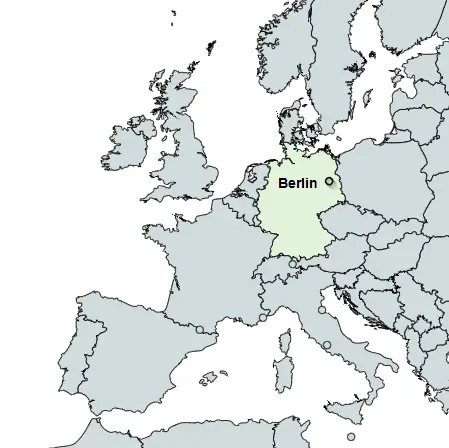
Detailed explanation
Riverbank Filtration is a technology that operates by pumping water from wells drilled along the banks of a river. During the pumping process, river water infiltrates into the riverbed sediments being purified along the way (Fig. 5).
RBF is a natural pre-treatment technology (nature-based solution, NBS) that uses sand and gravel aquifers as a natural filter – instead of chemicals – to pre-treat surface water and groundwater supplies, therefore being a cost-effective approach.
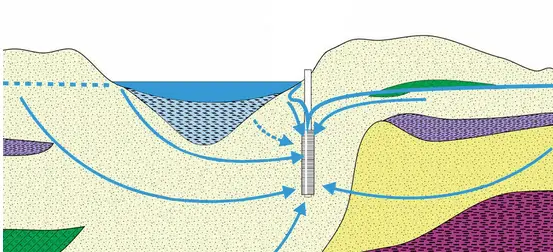
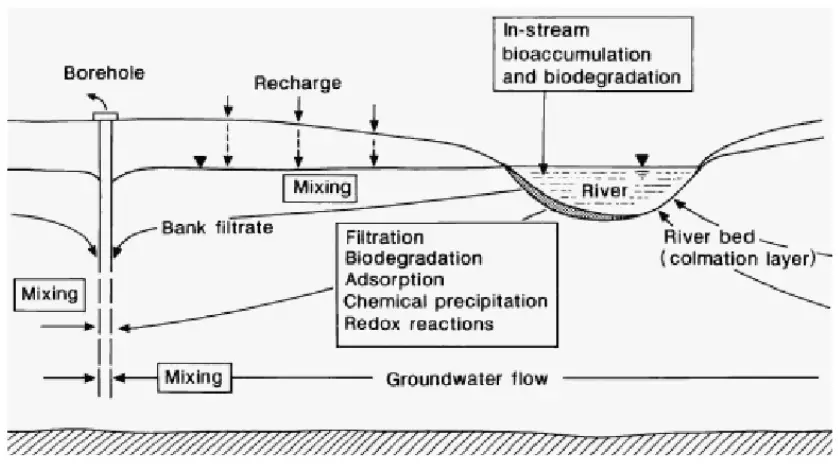
Fig. 6 shows the typical flow conditions associated with different types of bank filtration schemes.
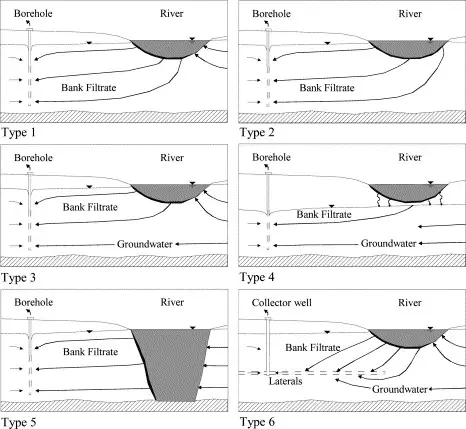
To improve water quality and to achieve better infiltration zones, a specific sand layer is more recently being incorporated in percolation ditches, channels, and ponds. A further stage of development has been the construction of recharge basins.
The water well intakes are located at a short distance away from a surface water source (usually less than 50 meters), which means that the percolation and retention time may vary from 5 to 100 days. The microbiological, chemical and physical water quality of surface water is much improved through RBF due to the combination of natural treatment processes, though a final treatment is usually still needed. Indeed, the increasing chemical pollution, which may result in high concentrations of nutrients, heavy metals, organic compounds, and micropollutants in the river water, lead to the introduction of supplementary pre- and post-treatment steps to build up a multiple-barrier system.
A variety of technologies may be applied to treat bank filtrate, depending on the river water quality (Fig. 7).
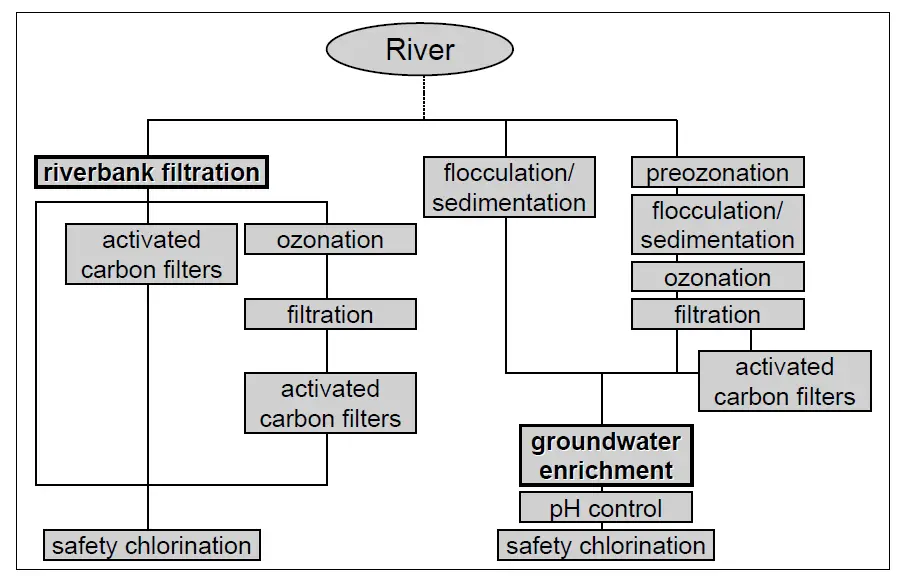
Fig. 7 also presents the usual treatment scheme when artificial groundwater recharge is added in infiltration basins to increase the water volume available.
RBF water treatment provides particle removal, pathogen removal, organic and inorganic chemical removal, peak smoothing in spills, temperature equalization, reduction in DBP formation, and production of more biologically stable water.
Future outlook
The majority of Berlin drinking water supply comes from bank filtration and artificial groundwater recharge. This is a process where river water infiltrates into the riverbed sediments being purified along the way and pumped in wells located along the river.
This natural pre-treatment technology, which uses the aquifer sedimentary material as a natural filter to pre-treat surface water and groundwater supplies, is being a cost-effective approach. Though bank filtration diminishes the loads of contaminants present in source water, there is still a need for future research in some aspects, e.g.:
– The influence of scale factors and local environmental conditions on soil-water interactions and biodegradation processes.
– The production of undesirable transformation products into the aquifer and eventually in drinking water wells.
– The seasonal dynamics of temperature and redox conditions temporally establishing separate zones where certain compounds can modify their reactivity, their capacity to produce metabolites, and/or their redox behaviour.
Globally, there are also future challenges derived from climate changes, such as higher temperatures, less summer precipitation, which can also impact in higher concentrations of nutrients and persistent trace organics which can led to a shift to more anoxic (anaerobic conditions) retarding the contaminants degradation.
Management of bank filtration schemes should be incorporated into wider catchment planning in order to limit potentially polluting activities in the groundwater recharge area and also to balance river infiltration losses with the ecological needs of the river.
Responsible entity
Berlinwasser Group (Fig. 1) is the entity responsible for the Berliner’s water supply “in the most efficient and sustainably way, ensuring its quality by acting with a sense of responsibility, showing commitment and using state-of-the-art technology”.

Institutional setting
RBF was first applied in Germany’s capital, Berlin, more than 100 years ago. For the past 70 years, bank filtration has produced approximately 60% of the city’s drinking water (Gillefalk et al., 2018). Methodologies keep improving since the beginning.
Water abstraction occurs in around 650 wells and is part of a semi-closed water cycle, where effluents from waste water treatment plants reach surface water bodies subject to water extraction via RBF for water provisioning (Fig. 2). In total, 9 lakes and many reaches of the lowland rivers Spree, Dahme and Havel are affected by RBF (Gillefalk et al., 2018).
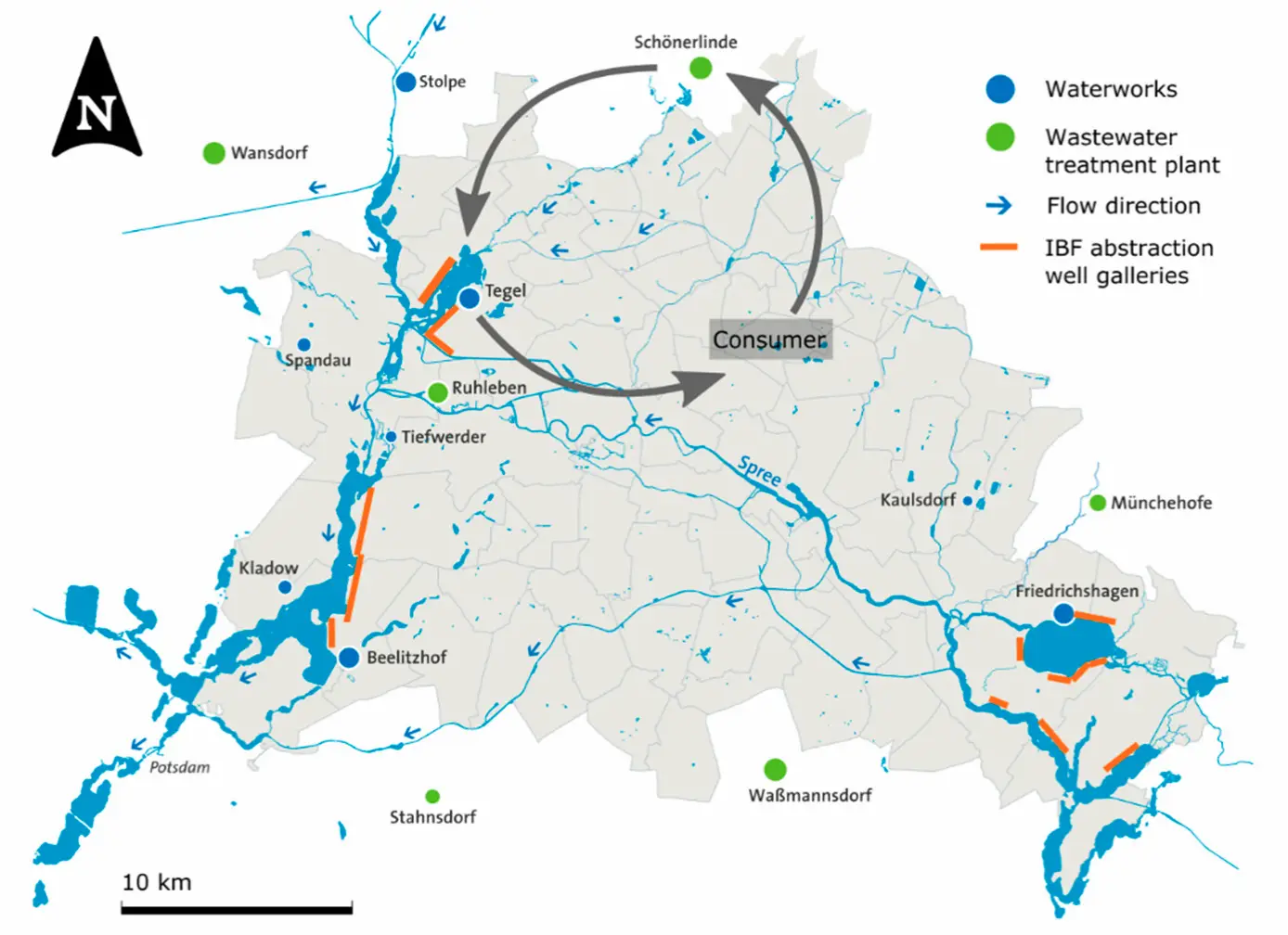
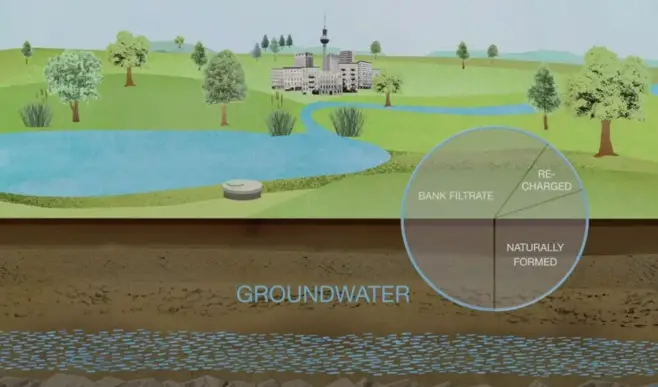
In order to be able to extract the required quantities, the groundwater is replenished with treated surface water, by impounding water into shallow earth basins or into natural ponds and ditches. The upper layers of soil act like a giant filter. The natural cleaning power of the soil improves the quality of the water physically, chemically and biologically, so that it is comparable to that of natural groundwater. On the way to the wells, percolated water also reaches the same temperature as groundwater.
Geographical setting
The Berlin water supply region has an area of 892 km2 and a population of 3.6 million. It extends 45 km at its widest point from east to west, and 38 kilometres from north to south. The River Spree flows through the city’s districts from east to west, forming a 7 kilometres wide valley, bounded by high areas in the north and south. It then flows into the valley of the River Havel near Spandau. These valleys are part of the “Warsaw-Berlin Glacial Valley” formed by the water masses which melted after the Ice Age. They are filled with sand and gravel at a depth starting at 30 metres. These gravel layers contain the groundwater resources which serve as the basis for Berlin’s drinking water supply (https://www.bwb.de/en/2164.php) (Fig. 4).
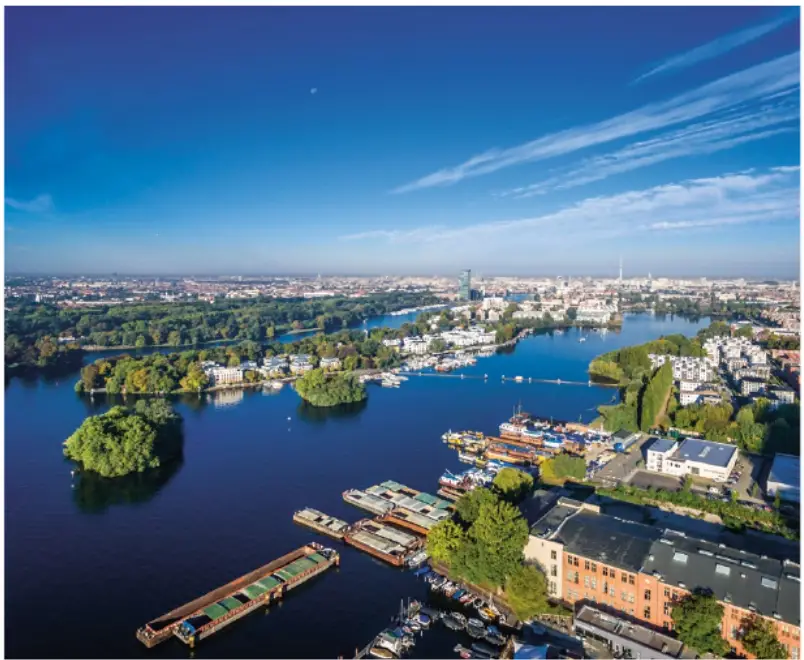
Historical overview
The effectiveness of bank filtration and artificial groundwater recharge has long been recognized in Germany. In the late 19th century, after various bacterial diseases caused by direct intake of drinking water from rivers (e.g. outbreak of epidemic cholera in Hamburg in 1892/93), direct extraction of surface water for public-water supply fell into discredit and was replaced or supplemented by artificial or natural subsoil passage of river water due to its efficiency in removing microorganisms from the infiltrating surface water (Schmidt et al., 2003).
Nowadays, approximately 16% of the drinking water in Germany is produced from bank filtrate and more than 300 water works use bank filtration, with roughly 50 plants based on artificial groundwater recharge (Fig. 8).
Berlin water supply is an emblematic example of RBF and is providing knowledge as a living lab for understanding and learning about the improvement of physical, chemical and biological water quality.
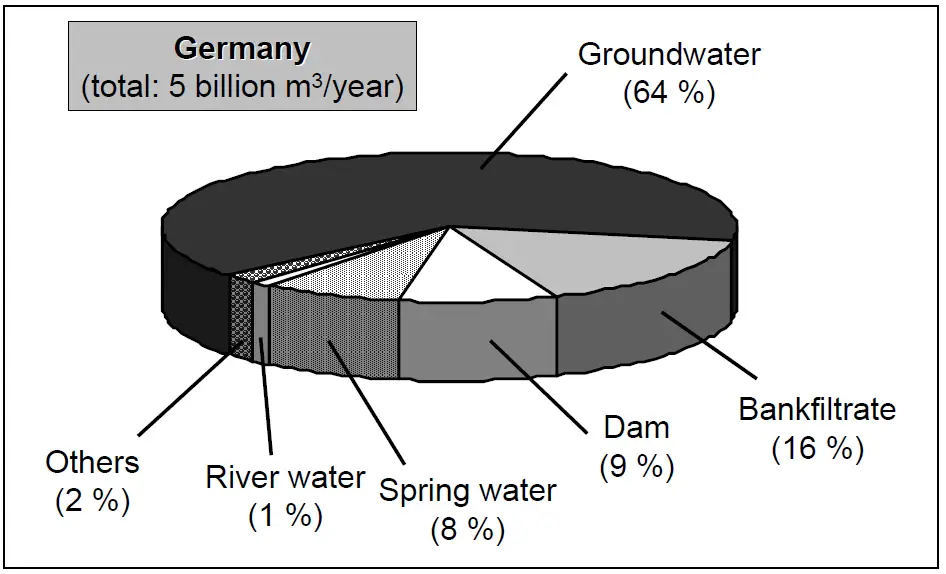
Evidence of benefits from implementation
Some of the benefits from RBF are:
- Reduces turbidity in a cost-efficient manner.
- Removes particles, biological contaminants and biodegradable compounds.
- Improves microbiological, physical and chemical water quality compared to surface water.
- Brings a more consistent water quality and temperature.
- Reduces the need/cost for disinfection.
- Decreases construction and operation costs, offering the lowest costs among water supply options (e.g. when compared with pumping from deeper aquifers).
- Generates less sludge.
- Has an easy maintenance.
- It is not susceptible to invasive plant infestation
REPLICATION POTENTIAL IN SUDOE REGION
The use of Riverbank Filtration in SUDOE areas has a strong replication potential since these are well established techniques tested in many hydrogeological setting with similar characteristics to SUDOE region. Furthermore, the specific conditions of this region (e.g. high temperatures with high evaporation; algae blooms in surface reservoirs) are naturally attenuated when using water from RBF.
The passage of water underground with a natural multiple barrier sand filter system provides several benefits for drinking water treatment. The results obtained in Berlin show that during infiltration and underground transport, processes such as filtration, sorption, and biodegradation produce significant improvements in raw water quality, therefore reducing subsequent treatment needs.
Key points of the innovative method
In Berlin, and Germany as a whole, bank filtration and artificial groundwater recharge have been used for the drinking water supply at several sites making use of different subsoil characteristics for water quality improvement, and no loss of purification capacity could be noticed (Schmidt et al., 2003).
Riverbank Filtration is an innovative method which is being continuously subject to improvements, being its main characteristics to:
- Bring a more consistent water quality (microbiological, physical and chemical) and temperature in a natural and cost-efficient manner.
- Reduce the need/cost for disinfection.
- Decrease construction and operation costs (less sludge, easy maintenance), offering the lowest costs among water supply options.
Acknowledgements
This innovative practice was selected from the initial broader thematic “Recharge, treatment and storage of alternative water sources in aquifers (Managed Aquifer Recharge)”, after discussion between PPA and LNEC.
References
BRGM (2017). AquaNES: developing systems for natural wastewater treatment. Retrieved March 22, 2018, from http://www.brgm.eu/project/aquanes-developing-systems-natural-wastewater-treatment.
Groß-Wittke A, Gunkel G, Hoffmann A. (2010). Temperature effects on bank filtration: redox conditions and physical-chemical parameters of pore water at Lake Tegel, Berlin-Germany, Jour-nal of Water and Climate Change 1(1), 55–66. https://iwaponline.com/jwcc/article-abstract/1/1/55/31005/Temperature-effects-on-bank-filtration-redox?redirectedFrom=fulltext
Regnery J, Barringer J, Wing AD, Hoppe-Jones C, Teerlink J, Drewes JE (2015). Start-up performance of a full-scale riverbank filtration site regarding removal of DOC, nutrients, and trace organic chemicals. Chemosphere 127, 136–142. https://www.researchgate.net/publication/272184885_Start-up_performance_of_a_full-scale_riverbank_filtration_site_regarding_removal_of_DOC_nutrients_and_trace_organic_chemicals
Reinhardt S., Hannappel S. (2003). Risikoabschätzung diffuser Schadstoffquellen für das Berliner Grundwasser. Senatsverwaltung für Stadtentwicklung Berlin, Berlin. https://www.berlin.de/umweltatlas/wasser/grundwasserqualitaet/2000/literatur/
Schmidt, C.K. (2003). Experiences with riverbank filtration in Germany. https://www.researchgate.net/publication/267779083_Experiences_with_riverbank_filtration_and_infiltration_in_Germany
Brauch H-J, Sacher F, Kühn W, Riverbank filtration: A very efficient treatment process for the removal of organic contaminants?, Proceedings, 2nd International Riverbank Filtration Conference (2003) 137-141
German Association for Water Resources and Land Improvement (DVWK) (1982). Artificial Groundwater Recharge, Volume I – 1. Regional aspects of artificial groundwater recharge, 2. Artificial groundwater recharge in water resources management, DVWK Bulletin No. 11, Hamburg, Berlin, Verlag Paul Parey.
German Association for Water Resources and Land Improvement (DVWK) (1982). Artificial Groundwater Recharge, Volume II – 3. Geological conditions of artificial groundwater recharge, 4. Qualitative goals for the water to be infiltrated, DVWK Bulletin No. 12, Hamburg, Berlin, Verlag Paul Parey.
German Association for Water Resources and Land Improvement (DVWK) (1982). Artificial Groundwater Recharge, Volume III – 5. Quality changes during infiltration and underground passage, DVWK Bulletin No. 13, Hamburg, Berlin, Verlag Paul Parey.
Gillefalk, M.; Massmann, G.; Nützmann, G.; Hilt, S. (2018). Potential Impacts of Induced Bank Filtration on Surface Water Quality: A Conceptual Framework for Future Research. Water 2018, 10, 1240. https://doi.org/10.3390/w10091240
Gutiérrez J.P., van Halem, D., Rietveld, L. (2017): Riverbank Filtration for the Treatment of Highly Turbid Colombian Rivers. In: Drinking Water Engineering and Science 10. https://doi.org/10.5194/dwes-10-13-2017
Hiscock, K.M.; Grischek, T. (2002). Attenuation of groundwater pollution by bank filtration. J. Hydrol. 2002, 266, 139–144. https://doi.org/10.1016/S0022-1694(02)00158-0
Kühn W., Müller U. (2000). Riverbank filtration – an overview, Journal AWWA (2000) 92, 60-69. https://awwa.onlinelibrary.wiley.com/doi/10.1002/j.1551-8833.2000.tb09071.x
Massmann, G.; Nogeitzig, A.; Taute, T.; Pekdeger, A. (2008). Seasonal and spatial distribution of redox zones during lake bank filtration in Berlin, Germany. Environ. Geol. 2008, 54, 53–65. https://doi.org/10.1007/s00254-007-0792-9
Massmann, G., Pekdeger, A., Heberer, T. et al. Drinking-Water Production in Urban Environments – Bank Filtration in Berlin. Grundwasser 12, 232–245 (2007). https://doi.org/10.1007/s00767-007-0036-7
Ray, C. (2002). Riverbank Filtration: Understanding Contaminant Biogeochemistry and Pathogen Removal, NATO Science Series, ISBN 978-94-010-0479-4 https://link.springer.com/book/10.1007/978-94-010-0479-4
Shaw, R. (Ed) (1999): Improving Pond Water. Technical brief No.47 WEDC, Loughborough University. UK. https://www.ircwash.org/sites/default/files/TB47-1996-Improving.pdf
Smout, I., Shaw, R. (1991): Intakes from Rivers. The Worth of Water: Technical Briefs on Health, Water, Sanitation IT, London. UK. https://www.emergency-wash.org/water/en/technologies/technology/riverbank-filtration
Zippel, M.; Hannappel, S. (2008). Evaluation of the groundwater yield of Berlin water works using regional numerical groundwater flow models. Grundwasser 2008, 13, 195–207.
Siegfried, K., Otter, P., Grischek, T., Bartak, R., Wang, S. (2018) AquaNES – Demonstrating synergies in combined natural and engineered processes for water treatment systems. Deliverable D1.2. www.aquanes.eu/
aquifer
NOTÍCIAS
Descubra mais sobre as notícias do projeto AQUIFER e sobre a gestão de aquíferos
NOTÍCIAS AQUIFER
Descrição e objectivos do projecto
The scientific community recommends a substantial improvement in the knowledge of aquifers, the establishment of reliable monitoring networks and a greater involvement of the administration and users to achieve a sustainable management of aquifers. The main objective...
Informação sobre o projecto
A Comunidade de Utilizadores de Água do Delta Llobregat concebeu bacias de recarga em Molins de Rei para recarregar o aquífero do Baix Llobregat. Vista de uma das bacias de recarga durante a fase de teste A Comunidade de Utilizadores de Água de Llobregat Delta é um...
Histórias de sucesso na gestão das águas subterrâneas
Compilação de histórias de sucesso na gestão das águas subterrâneas. Ao longo do mês de Abril, os 30 casos de práticas inovadoras na gestão das águas subterrâneas já foram seleccionados pelos agrupamentos que participam no projecto: PPA, CWP e AV. A tarefa começou com...
PROPONHA UMA
PRÁTICA INOVADORA
Está a desenvolver ou implementar uma prática inovadora em matéria de gestão de aquíferos e deseja referência-la na plataforma do projeto AQUIFER?
Preencha o formulário e faça uma proposta aos parceiros do projeto AQUIFER.
THE E-BOOK
O Aquífero oferece uma gama de práticas inovadoras de gestão da água. Pode descarregar todas as nossas fichas técnicas aqui.
E-BOOK DE PRÁTICAS INOVADORAS
DOCUMENTAÇÃO
Aprofunde a informação relacionada com a gestão dos aquíferos